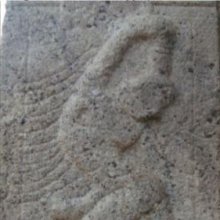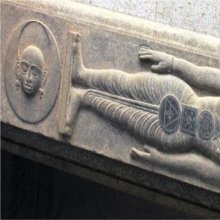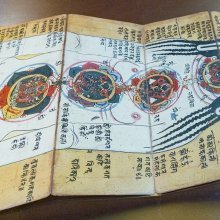Sahasrara, Sahasrāra, Sahastrara, Sahasra-ara: 15 definitions
Introduction:
Sahasrara means something in Hinduism, Sanskrit, Jainism, Prakrit. If you want to know the exact meaning, history, etymology or English translation of this term then check out the descriptions on this page. Add your comment or reference to a book if you want to contribute to this summary article.
Sahasrara has 14 English definitions available.
Images (photo gallery)
Languages of India and abroad
Sanskrit dictionary
[Deutsch Wörterbuch]
Source: Cologne Digital Sanskrit Dictionaries: Böhtlingk and Roth Grosses Petersburger WörterbuchSahasrāra (सहस्रार):—(sahasra + 1. ara)
1) adj. tausendspeichig: Viṣṇu’s Diskus (Rad) [Bhāgavatapurāṇa 9, 5, 4.] —
2) m. n. eine für eine umgestülpte Lotusblüthe geltende Stelle auf dem Kopfe [Śabdakalpadruma] nach dem [TANTRASĀRA.]
Sanskrit, also spelled संस्कृतम् (saṃskṛtam), is an ancient language of India commonly seen as the grandmother of the Indo-European language family (even English!). Closely allied with Prakrit and Pali, Sanskrit is more exhaustive in both grammar and terms and has the most extensive collection of literature in the world, greatly surpassing its sister-languages Greek and Latin.
See also (Relevant definitions)
Partial matches: Sahasra, Ara.
Starts with: Sahasraracakra, Sahasraraja, Sahasrarakalpa, Sahasrarashmi, Sahasrarashmitanaya.
Full-text (+50): Sahasrarakalpa, Kundalini, Cakra, Sahasraraja, Sahassara, Vaimanika, Shrim, Shatara, Mahanada, Geya-cakra, Citrasundari, Dattavirya, Khecarimudra, Rupatita, Satyashri, Svadhishthana, Kalpa, Shatcakra, Chatra, Damadhara.
Relevant text
Search found 28 books and stories containing Sahasrara, Sahasrāra, Sahastrara, Sahasra-ara; (plurals include: Sahasraras, Sahasrāras, Sahastraras, aras). You can also click to the full overview containing English textual excerpts. Below are direct links for the most relevant articles:
Tattvartha Sutra (with commentary) (by Vijay K. Jain)
Verse 4.19 - The sixteen Kalpa, nine Graiveyaka and five Anuttara < [Chapter 4 - The Celestial Beings]
Verse 4.29 - Lifetime in the first two Kalpa among the heavenly beings < [Chapter 4 - The Celestial Beings]
Verse 4.31 - Lifetimes of Deva from Brahmaloka to Acyuta kalpa < [Chapter 4 - The Celestial Beings]
Cidgaganacandrika (study) (by S. Mahalakshmi)
Verse 227-228 [Sahasrāra and shower of Somarasa] < [Chapter 4 - Fourth Vimarśa]
Verse 101 [Nāda’s path] < [Chapter 3 - Third Vimarśa]
Verse 96 [Praṇava produced by Cakrapañcaka in Kuṇḍalinī] < [Chapter 3 - Third Vimarśa]
Paduka-panchaka (the five-fold footstool) (by Arthur Avalon)
Shat-cakra-nirupana (the six bodily centres) (by Arthur Avalon)
Trishashti Shalaka Purusha Caritra (by Helen M. Johnson)
Part 6: Varuṇā’s third incarnation < [Chapter II - Previous births of Pārśvanātha]
Part 32: Description of the Upper World (ūrdhvaloka) < [Chapter III - The initiation and omniscience of Ajita]
Part 5: Marubhūti’s third incarnation < [Chapter II - Previous births of Pārśvanātha]
Bhagavati-sutra (Viyaha-pannatti) (by K. C. Lalwani)
Part 12 - On celestial positions < [Chapter 2]
Part 8 - Monk Kurudattaputra and other heavens < [Chapter 1]
Part 1 - Poisonous beings < [Chapter 2]
Related products





